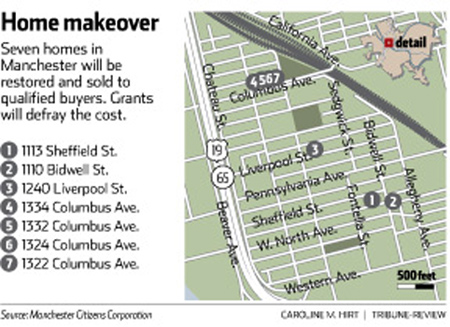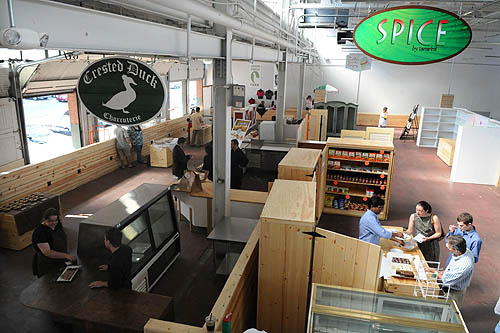
Category Archive: Main & Elm Street Programs
-
Denis Theatre in Mt. Lebanon Won’t Be Silent Screen Too Long
By Rick Wills
PITTSBURGH TRIBUNE-REVIEW
Thursday, September 2, 2010A group working to renovate and reopen the Denis Theatre in Mt. Lebanon signed a sales agreement Wednesday to buy the building.
The Denis Theatre Foundation agreed to pay $668,750 for the theater on Washington Road. The theater, which opened 72 years ago, closed in 2004.
The deal should be final within 60 days, said Anne Kemerer, the foundation’s executive director.
“This is almost like an unattainable dream, especially after the economy got bad and fundraising became so difficult,” Kemerer said. “To me, a main street has a theater on it.”
The foundation has raised $663,000 and aims to raise another $1.8 million for the first phase of the renovation, which includes opening one screen, updating or replacing basic systems and installing an elevator.
The Encore, the first of three planned screening rooms, is expected to open in 2012.
The project’s second phase includes opening two more screens, restoring a stage in one theater and adding meeting rooms.
So far, the foundation has received 436 donations — the two largest are $155,000 from an anonymous benefactor and $100,000 from The Pittsburgh Foundation.
“The goal of this project is to serve a wide demographic over the South Hills. There is something about a community theater that makes a community stronger,” said Mark Lynch, a spokesman for the foundation.
The Denis opened in 1938.
“I remember standing in line to see ‘Benji’ there. The Denis Theatre is an historic building that holds lots of nostalgia for people in the area,” said Jennifer Smokelin, a foundation board member and Mt. Lebanon resident.
-
Work on Former Hollow Tavern Progressing
By Jewels Phraner
LIGONIER ECHO
Thursday, September 2, 2010
Fred Haeflein works on reviving the Hollow Tavern on Route 30 outside of Ligonier. Jared Wickerham | Tribune-Review
Saving Sleepy Hollow hasn’t gone exactly the way owner Fred Haeflein expected.
He’s had a skilled crew at work rebuilding the log landmark, but now he’s looking for a good chef and manager to operate the restaurant.
After an arson destroyed the building in February 2008, causing so much damage that Unity code enforcement officer Merle Musick condemned the property, Haeflein bought it with the intention of restoring it.
Financial troubles plagued the project early on, and this summer Haeflein said he has struggled to find the right person to run the restaurant. Although he has fond childhood memories of the restaurant, he has no interest in running the facility once it’s finished.
“I don’t cook. I’m not a restaurant manager,” Haeflein said. “I build things. I save things. I just want this building here.
“I need a good restaurateur – no, I need a great restaurateur – to keep this place running for a long time,” he said.
When the project ran into financial problems in early 2007, The Progress Fund, a Greensburg-based nonprofit lending organization approached Haeflein about a loan.
“That valley is so great. So many people enjoy driving through it. And we thought it would be a nice venue for people to stop and enjoy the valley,” said David Kahley, chief executive officer for the organization, which focuses on tourism-oriented projects.
Project loan officer Bob Patter said that while people might not see progress as they drive by the building, that doesn’t mean work isn’t being done behind the scenes.
“It’s still a very active project,” he said. “Fred is moving forward with it. Perhaps not at the pace everyone would like to see, but he’s trying to find the right person to run the restaurant for him.”
Haeflein said he expected to buy exterior logs for the building. But he wasn’t able to find the correct size and had to custom-make them instead.
“I wanted them to be as close to the original (Sleepy Hollow) as possible, and you just can’t buy logs that width anymore,” he said.
So Haeflein spent part of the summer using an ancient mill in his New York shop to cut logs, then transporting them to Ligonier.
“This is probably a lot like how the original logs were made,” he said. “It’s a pure miracle that (the mill) actually worked. That mill is probably as old as this building and hasn’t been used in 20 years.”
For now, only a few logs are secured to the building, but Haeflein said he will be back to finish the job soon.
Kelly’s Sleepy Hollow LLC was formed by Haeflein and his brother, Rich, who have been restoring the landmark west of Ligonier for about two years.
Edgar Wiltrout of Ligonier is serving a 10- to 28-year prison sentence for torching the restaurant and tavern on Feb. 23, 2008, because the former owner owed Wiltrout $1,000 and fired his girlfriend as a cook.
-
7 Homebuyers Sold on Manchester Vision
By Adam Brandolph
PITTSBURGH TRIBUNE-REVIEW
Thursday, September 2, 2010
Linda Nelson, chairwoman of the Manchester Citizens Corporation, inspects one of the properties being restored on Columbus Avenue in Manchester. The home was purchased as part of the Great House Sale. Jasmine Goldband | Tribune-Review
For the first time in years, Anthony Clark sees a reason to invest in his North Side neighborhood.
“Manchester is really starting to get going, and after 15 years of renting, I think it’s a good time,” said Clark, 44. “I think we’re about to see some really great things.”
For years, the city demolished vacant homes in Manchester, turning usable buildings into weed-filled lots that became overrun with graffiti and trash. The vacant lots made selling homes difficult, and people living there say the community suffered despite the fact that police records show the number of crimes fell by nearly half over the past decade.
“When you have a tooth out, the disease begins to spread,” said Linda Nelson, chairwoman of the Manchester Citizens Corporation, a community group founded in 1965 that helped spur more than $40 million in developments and initiatives. “If (buildings) come out, it’s definitely a hindrance. If we can renovate them, it’s a plus.”
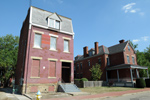
An abandoned structure (left) on the 1100 block of Bidwell Street in Manchester is one of several slated for rehabilitation. Jasmine Goldband | Tribune-Review
With the group’s managing director Stanley Lowe urging the city to save buildings from demolition, the wrecking ball slowed. Along with the Pittsburgh History & Landmarks Foundation, it identified 110 buildings that should be saved, 63 of which are considered a priority.
Lowe said he reminded members of the city’s Historic Review Commission about the neighborhood’s rich architectural and cultural heritage, which helped Manchester achieve city and national historic status in 1979.
“Once you tear down the building, you can never go back,” Lowe said.
In October, the citizens’ group showcased seven homes to be restored by March. More than 100 people, some from as far away as Venezuela and Colombia, attended a two-day session that included a seminar educating them about how to buy one of the homes.
Twenty-five people put down $1,500 deposits, and seven qualified buyers were chosen at random to buy the homes. The rest were put on a waiting list for future restorations.
“The homes were a terrible mess,” Nelson said. “But the people who came in saw our vision.”
The cost to restore each home will range from $150,000 and $450,000, but they will sell for $90,000 to $200,000.
Incentives totaling $2 million for the buyers will be paid by grants from the city’s Urban Redevelopment Authority, the federal Department of Housing and Urban Development, Allegheny County, the Pittsburgh History & Landmarks Foundation’s Landmarks Community Capital Corporation and the Allegheny Foundation.
City Councilman R. Daniel Lavelle, whose district includes Manchester, said the strategy “fits the city’s economic reality.”
“The city can’t afford to do it all at once, so (the citizens’ group has) identified key properties they want to save,” Lavelle said. “I think it’s a tremendous project.”
Preserving the “architectural fabric” of the historic district has been ongoing since the 1970s, said Arthur Ziegler, president of the landmarks foundation.
Rob Stephany, executive director of the redevelopment authority, said the restorations are a “really bright strategy,” especially because they’re near construction at Columbus Square, a $15 million, 31-home development on four acres.
“Manchester has everything working for it,” he said.
-
Downtown’s EQT Plaza No Longer on the Block
‘Recapitalization’ shinier than sellingWednesday, September 01, 2010By Mark Belko, Pittsburgh Post-GazetteThe owner of one Downtown building has removed its “for sale” sign.
Rather than sell, New York-based Blackstone Group has decided to retain ownership of EQT Plaza, formerly known as Dominion Tower, and refinance its debt.
“They just decided with the way the markets are today, a recapitalization was a better option for them,” said Gerard Sansosti, executive managing director of HFF Inc. in Pittsburgh, which was marketing the building for sale.
Aaron Stauber, president of New York-based Rugby Realty, which has extensive property holdings in Pittsburgh, said refinancing was an attractive option for building owners these days because of very low interest rates. One advantage to refinancing rather than selling, he noted, is that the owner does not have to pay capital gains taxes.
HFF had announced in February that it was putting the 32-story office building, now the headquarters of EQT Corp., up for sale on behalf of Blackstone, which bought it for $45 million through a sheriff’s sale in 2005.
While HFF had received offers for the 23-year-old building, located on Liberty Avenue, Mr. Sansosti said Blackstone ultimately decided not to sell.
“I think it’s going to be off the market for a while,” he said.
As of February, the 615,942-square-foot office tower was about 96 percent leased. EQT moved into the building from the North Shore last year.
EQT Plaza was one of a handful of high-profile buildings Downtown to go up for sale this year, sparking a wave of publicity and even inquiries from city hall about the reasons for the moves.
Others on the market include the landmark Macy’s department store (formerly Kaufmann’s); the four-building Gateway Center complex, the linchpin of the city’s first renaissance; the Henry W. Oliver Building; the Regional Enterprise Tower, formerly the Alcoa Building; and American Red Cross of Southwestern Pennsylvania building, Boulevard of the Allies.
-
City’s Newest Indoor Market Opens in Strip Next Week
Wednesday, September 01, 2010By Diana Nelson Jones, Pittsburgh Post-GazetteWhen the Pittsburgh Public Market in the Strip opens Friday, patrons will see some tried-and-true faces — La Prima Coffee, the Common Plea and Fudgie Wudgie among them.
But the new indoor market in the Produce Terminal Building on Smallman Street marks the retail debut of a number of the 43 vendors, whose wares will include organic produce, coffee, specialty meats, pastries, Indian food, pierogies, organic teas, local wines, micro brewed beer, skin care products, knitted goods and jewelry.
The Produce Terminal was built in 1926 by the Pennsylvania Railroad. The market house, located between 16th and 17th Streets, features horizontal roof-line skylights and doors that open for a river view. It will be open Fridays from 9 a.m. to 7 p.m., Saturdays from 9 a.m. to 5 p.m. and Sundays from 10 a.m. to 4 p.m. The grand opening festivities are Sept. 10-12.

Debbie Jacknin of Jenn's Jems displays her jewelry and other items in her booth at the new Pittsburgh Public Market in the Strip District on Tuesday. Robin Rombach/Post-Gazette
The project began almost nine years ago as a dream of Neighbors in the Strip.
“Eight years, three months and two days,” said Tom Goslin, the Market Council president and owner of American Dispatch.
The dream got state funding in 2005, the same year the Urban Redevelopment Authority, which owns the building, did a feasibility study. The URA invested $100,000. The total price tag of $1.25 million was filled out by federal, state and local foundation money.
“This was part of our neighborhood improvement strategy,” said Becky Rodgers, executive director of Neighbors in the Strip. “It’s been a goal of ours to bring back a piece of history to Pittsburgh.”
The city once had four enclosed marketplaces. The last of them closed in 1965 to create Allegheny Center Mall.
Several years ago, the board of Neighbors in the Strip visited existing markets: the Reading Terminal Market in Philadelphia, the West Side Market in Cleveland and the Central Market in Lancaster, hoping to bring a similar concept to the Strip.
Cindy Cassell, market manager, said the market council selected vendors “in the context of the entire Strip. We had a series of meetings with existing businesses and came up with a list of things that would contribute the most diversity to the Strip.”
Edith Davis and Eartha Sewell, of Edith and Eartha Textiles, are among several woman- and minority-owned businesses in the marketplace. They were in a knitting group, then started knitting together, specializing in scarves and wraps.
“People said they wanted to buy them” said Ms. Sewell, “so we thought we could make a business out of it. Then this opportunity came up. You know what they say: Do what you love.”
The first vendor’s space in the markethouse is Kevin and Adam Costa’s Crested Duck Charcuterie, where the brothers are opening their first specialty meat shop. Kevin was mentored by a chef during a stint in Cincinnati, “then I just played with it and tried things. I did vegan baking at a farmer’s market in Indianapolis” before returning home to Pittsburgh last year.
Debbie Jacknin’s 23-year-old daughter Jenn began making jewelry when she was 14. “She taught me,” said Ms. Jacknin. “We’ve done craft shows before but nothing like this,” their first retail presence — Jenn’s Jems.
“A friend told me about this marketplace. I had to submit a video. And they accepted us.”
Diana Nelson Jones: djones@post-gazette.com or 412-263-1626. -
Public Market in Strip to Open Sept. 10, Feature Specialty Items
By Michael Machosky, PITTSBURGH TRIBUNE-REVIEW
Tuesday, August 31, 2010
Siblings (from left), Xanthe Schandelmeier, 5; Coco, 9; and Vivienne, 7, of Squirrel Hill, sample sweets at Prasad Potluri's Spice by Tamarind booth in the Pittsburgh Public Market. More than 40 vendors will showcase their wares in a 10,000-square-foot area of the Produce Terminal Building. The grand opening will be Sept.10. The market will be open Fridays, Saturdays and Sundays. Heidi Murrin | Tribune-Review
From homemade pierogies and duck pate with pistachios and fresh herbs to old-school Italian ice and locally-brewed beer — the Pittsburgh Public Market is so close, you can almost taste it.
“It will be 45 years in November since Pittsburgh had a public market,” said Becky Rodgers, executive director of Neighbors in the Strip, who vividly remembers the last one — the long-demolished North Side Market House. “My great uncle Bob was a butcher there. My whole family used to go — it was like a sight-sound-smell extravaganza.”
Starting with a soft opening Friday, the long-delayed Pittsburgh Public Market finally will open to the public. On Sept. 10, there will be a clamorous Grand Opening marked by the ringing of bells — the public is invited to bring their own to add the racket.
Unlike Pittsburgh’s seasonal farmers markets, this indoor market will be open every weekend year-round. The $1.3-milllion project will have more than 40 vendors in 10,000 square feet of space — which is only a small slice of the blocks-long Produce Terminal Building along Smallman Street, where it is housed. The entrance is near 17th Street.
It’s been a delicate balancing act from the start, which began in 2001. Spaces from 6,500 square feet to 30,000 square feet were considered. And finding a way to avoid diverting business from the Strip’s established food purveyors was a major concern.
“You’ll notice we don’t have a fish place in our market — that’s a very usual kind of thing to have in a market,” said Cindy Cassell, the market manager for Neighbors in the Strip. “We don’t have a cheese place. We’re really working hard not to replicate existing niche markets.”
Vendors quite literally are all over the map — from Gosia’s Pierogies to Sito’s Mediteranean dressings, to Ekh’s authentic Indian vegetarian dishes, to Mushrooms for Life, foraged from around Western Pennsylvania.
Kevin Costa was slicing up duck pate and “Gin & Juice Salami” Tuesday morning at the Crested Duck Charcuterie, a specialty meat market with a booth near the entrance.
“We wanted to start our own business, but it would have been impossible to duplicate the foot traffic of the Strip, so this is perfect,” Costa said.
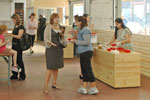
On Sept. 10, the PIttsburgh Public Market will open for business inside the Produce Terminal Building in the Strip District. More than 40 vendors will showcase their wares with everything from baked goods to artwork, barbecues to microbrews. Heidi Murrin | Tribune-Review
Starting a business is a lot less daunting for vendors when they’re paying $25 a day for a 10-foot-by-6-foot booth or $50 a day for a 10-foot-square booth.
“One of our challenges has been to get the concept across that, while this is not necessarily full-time, it’s also not a farmer’s market where you just show up and put your tablecloth down,” Cassell said. “It’s a little more permanent than that. So there is some planning involved for your booth. The booths are small, but from a financial perspective, I think it’s very accessible for a new business.
“We do have a lot of startups that are coming in,” she said. “That’s one of our goals, to incubate new businesses. And you know everything will be realized when they grow up and need a storefront, and can, hopefully, take an empty storefront in the neighborhood.”
Other vendors just want a little more visibility.
The Spice by Tamarind booth stocks Indian spices, snacks, chutneys, ready-to-eat meals and specialties like eggless cakes. Owner Prasad Potluri runs several Indian restaurants and small grocers in the region.
“It’s to make people aware of the restaurants and food,” Potluri said of the reason behind his participation.
For some, it’s simply a way to make it easier for customers to find their product.
Scott Smith, of East End Brewery, always assumed most of the sales for his Big Hop IPA and Black Strap Stout would be wholesale to bars and restaurants. But craft-beer fans just kept searching out the tiny, out-of-the-way brewery.
“We’re in an unmarked building in Homewood, and half our business is walk-in traffic,” Smith said.
Now, customers can sample Fat Gary Nut Brown Ale and Pedal Pale Ale at the Pittsburgh Public Market, and fill up their growlers to take home.
Not everything in the market is edible.
Babouche sells Moroccan crafts, jewelry, scarves and leather goods. Iron Eden is renowned for beautiful ironwork — flowers, trellises, sculpture — often made from recycled scrap metal. Jenn’s Jems features knit and crocheted items, and handmade jewelry.
Markets in other cities — like Cleveland’s West Side Market and Seattle’s Pike Place Market — have become first-day tourist attractions.
The Pittsburgh Public Market is starting on a much smaller scale, of course, but drawing new shoppers to the Strip is part of the plan.
“When we had Campos do a consumer market survey for us in 2006, at that time, we were planning for about 30,000 square feet,” Cassell said. “According to the consumer survey, it would add about 12,000 additional shoppers to the Strip every week. Now we’re scaled back in 10,000 square feet. But one of our goals is to increase the customer base for the entire Strip.”
Pittsburgh Public MarketWhen: Opens Friday, with Grand Opening Festivities Sept. 10-12
Hours: 9 a.m.-7 p.m. Fridays, 9 a.m.-5 p.m. Saturdays, 10 a.m.-4 p.m. Sundays
Where: 17th and Smallman streets, Strip District
Details: 412-281-4505 or website
-
Roxian (Theater) Ready for Start of Renovation
Thursday, July 29, 2010By Brian David, Pittsburgh Post-GazetteWhen Andrew Hieber saw a “for sale” sign on the Roxian Theater in McKees Rocks, he had an instant vision.
A musician, he knew the local concert scene. A longtime restaurant worker, he knew entertainment. As the owner of a martial arts and fitness gym, he knew business. As a native of The Rocks, he knew what lower Chartiers Avenue had once been. And as a lucky early investor in America Online stock, he even had a bit of money.
“I had always looked at the Roxian as a great music venue,” with nice acoustics and a size that slotted neatly between the clubs and the stadiums, he said. Built in the late 1920s as a movie theater and used for every conceivable stage show since, the Roxian was well-worn but structurally sound. Mr. Hieber figured he could slap on some paint, work his connections and start bringing in mid-level touring bands.
That was 2004. The vision has taken a couple of beatings since. “I don’t get excited anymore,” Mr. Hieber said. “I got really excited five years, six years ago, and it just got me frustrated.”
But if he starts feeling the rush again, it is excusable — the grand old theater is in the process of being gutted in the first phase of a renovation that should have it open by next year.
The plan is to open a side wall to create space for ticket booths and a new entrance, refurbish the main floor with a new bar area and removable seats, raise the stage for safety and better sightlines and replace the 285 balcony seats with 225 seats sized for modern rear ends. The building is also getting an elevator, new wiring, plumbing and ventilation systems, new bathrooms and new light and sound systems.
In all, the cavernous space — five floors on a 27,000-square-foot footprint — will be able to hold 1,500 for a concert, but also will be able to function café-style for banquets, receptions and smaller shows.
In some ways, all this is possible because of the first beating that was administered to Mr. Hieber’s dream six years ago.
When he inquired about buying the building, he was put in touch with an old Sto-Rox schoolmate, Taris Vrcek, who had recently taken on leadership of the McKees Rocks Community Development Corp. Mr. Vrcek told him the Community Development Corp. was acquiring the building and already had someone lined up to be owner/operator of the theater business.
But he promised to keep Mr. Hieber atop the list if anything happened, and when the original operator bailed out six months later, he gave Mr. Hieber a call.
The next blow came when Mr. Vrcek said the community corporation would rent him the building, but would not sell it.
“I said, ‘Why should I rent it from you when I can own it myself?’ ” Mr. Hieber said. “But he waved the carrot of nonprofit grant money in front of my nose.” The Community Development Corp. could get the kind of support that no for-profit business could.
The final blow made the necessity of that arrangement clear; architectural studies showed that to meet code, the theater would need an elevator and bathrooms with 42 toilets, far beyond what it had. “That kind of tore down my dream,” Mr. Hieber said.
Mr. Vrcek, however, was undeterred. He had a strong vision of what lower Chartiers could be, and the redeveloped Roxian was “the game-changer, the catalyst for the rest of the strategic plan,” he said.
“Bring 1,000 people in here several times a week, imagine what that would do. It would really give us a chance to market some beautiful old buildings.”
The neighborhood already has Hollowood Music Center, a music store with a regional clientele, and the Roxian is catty-corner from the Father Ryan Arts Center, a nonprofit facility that supports visual and performing arts.
Mr. Vrcek sees other clubs and restaurants sprouting, capitalizing on the arts-centered theme. “The Roxian could really make this a destination of choice,” he said.
Mr. Vrcek spent years obtaining a $500,000 grant from the state Department of Community and Economic Development and a $250,000 county grant. He also brought in Dennis Stasa, owner of the McKees Rocks company Penn Interiors, as a private partner. The company is doing the renovation work and will have an ownership stake.
Mr. Hieber described Mr. Stasa as “a visionary” when it comes to the building’s interior. “He’s sure when he’s done with this that he’s going to end up on the cover of Pittsburgh Builder magazine.”
The full flow of Mr. Stasa’s vision may have to wait a while, though. Mr. Vrcek said the focus for now is on getting the building ready for effective use as a concert venue, with the “extra bells and whistles” to follow as money is available.
That puts the current focus on the building’s mechanicals and on bringing the main floor and main stage up to standards.
The “bells and whistles” could be a lot of fun, though, because the building is a maze of half-hidden rooms, like a real-life “The Phantom of the Opera” set.
There are rooms flanking the stage along the back wall, stacking up to the ceiling. These were delicately referred to as “sleeping rooms” in the theater’s club days and could be used as “green room” space for artists.
Mr. Hieber envisions opening a small restaurant in a room above what is now the entrance and a cigar bar in an identical room above that. There’s a lounge between the two entrances that was, until recently, adorned with hanging beads and disco posters. The projection room still holds the original projectors — huge machines from the dawn of the movie era.
And then there’s the basement, a huge space previously used as a sports and dance bar; Mr. Hieber envisions a similar use in the future.
“I’ve been through the building probably 20 times,” Mr. Hieber said, “and every time I find a new space I didn’t know about.”
And standing in the empty, dusty darkness of the main floor, he betrayed the fact that the excitement really is still there.
“It’s going to be awesome,” he said.
-
Rural Freeport Theatre Festival Finds Success Turning History into Drama
Thursday, July 15, 2010By Kate Luce Angell – Pittsburgh Post-Gazette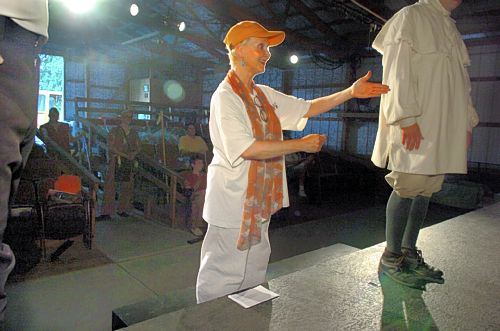
Marushka Steele directs actors in a dance scene in the play "Battle of Kittanning" set in 1756 and written by her husband Rennick Steele. Bill Wade/Post-Gazette
The brainchild of Rennick and Marushka Steele, the Freeport Theatre Festival in Allegheny Township is celebrating its 21st season this summer, an accomplishment by any standard.
But what makes its success even more significant is that, in these increasingly tough economic times for arts organizations, the Freeport Theatre Festival thrives by going against much of the conventional wisdom for successful small theaters.
Instead of concentrating on popular scripts, the festival specializes in history plays — often local history — and often written by Mr. Steele as well as other local playwrights.
The Steeles also chose to found the festival in a rural area, almost 45 minutes from Pittsburgh and its theatergoers. Their performance space, a converted machinery barn, sits on White Cloud Farm in Armstrong County, on land that has been in Mr. Steele’s family for generations.
Mrs. Steele attributes much of the success to the company’s focus on serving the people of the area. “We respect our audience, and they love history,” she said.
“Cauldron of Steel,” Mr. Steele’s play about immigrants in Vandergrift at the turn of the 20th century, is playing until July 25.
Starting Aug. 13 is the final play of the summer season, “Bertha and Bailey’s Circus,” a comedy also by Mr. Steele.
How Mr. Steele, who with Mrs. Steele was involved in New York City’s Off-Off-Broadway Alliance of the 1970s, decided to return to his family’s farm and found the Freeport Theatre Festival is another story that goes against expectations.
Mr. Steele lived on the farm until age 15, when his family relocated to Columbus, Ohio. He earned a bachelor’s degree in English from Ohio State University, served a stint in the Army and then moved to New York to become a professional actor and playwright.
“It was an exciting time,” said Mr. Steele of the 1970s, adding that the rules for mounting low-budget productions were much looser then, allowing him to produce several of his own plays with professional casts.
He met Mrs. Steele, then Marushka Dembecki, who had come from her hometown of Detroit to try her luck as a ballet dancer and as a professional actress. They married in 1980.
The Steeles left New York for Los Angeles in 1983, where Mr. Steele earned a master’s degree in education at the University of California at Los Angeles.
His father had returned to the family farm after his retirement and the Steeles joined the family there in the late 1980s. They founded the Freeport Theatre Festival in 1989.
Mr. Steele said he had found his family’s own long history in the area to be a rich source of inspiration for his plays.
Of Scotch-Irish background, the Steeles moved to the Hannas Town and Mount Pleasant area in the 1770s, later settling near Freeport.
Adjacent to the Steeles’ property is a cemetery dating from when a church stood nearby; the Steeles that are buried there “populate my plays,” Mr. Steele said.
For example, he said, “the town doctor in ‘Cauldron of Steel’ is my grandfather’s first cousin, whose stone is up there.”
In its early years, the festival concentrated on popular plays by known names, but in 1995, Mr. Steele presented a full-length play about a forebear of his mother’s, a Native American woman whose name was Nancy Ward.
“Beloved Woman” proved that historical drama could be a hit, and was the first of the festival productions to make use of historical re-enactors — people who take on roles of historical figures.
On June 17, Mr. Steele retired from his job as seventh grade teacher in the Armstrong School District, and he says he looks forward to dedicating even more time to the festival. The Steeles are both in their 60s.
Operating as a nonprofit, the festival is lucky in that it hasn’t yet had to raise ticket prices, Mrs Steele said.
“We break even. Three-quarters of our funds come from ticket sales, the rest from our corporate and individual sponsors.”
The couple is in the middle of a fundraising campaign to improve the performance space and add “real restrooms.”
The Steeles also plan a return to some of their more ambitious productions of the past, plays like “The Battle of Kittanning” that employed large casts, outdoor locations and even, on occasion, the farm’s horses and sheep.
“The Battle of Bushy Run will have its 250th anniversary in 2013,” noted Mrs. Steele. “My husband has said that in 2012, he’ll write a play about it.”
Bushy Run was an important 1763 battle during the French and Indian War that took place near Harrison City in Westmoreland County.
What has become clearer than ever over the years, said Mrs. Steele, is the power of both history and theater to remind us of our connections to our communities and each other.
“We’re all part of the same human family. And art helps us see that.”
Details: www.freeporttheatrefestival.org.

